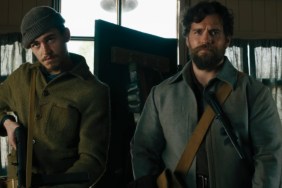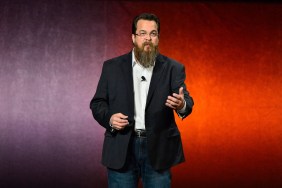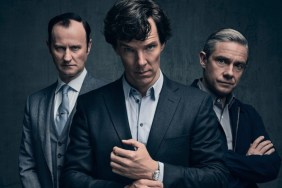If you’ve become cynical or wary of movies set in Iraq, thinking you’ve seen everything that they have to offer, then prepare yourself for Kathryn Bigelow’s The Hurt Locker, a movie that defies its somewhat overused setting to tell an edge-of-your-seat tale of military bomb squads whose lives are constantly put in danger as they try to protect others.
Based on the experiences of journalist Mark Boal, who also wrote the screenplay, it follows a squad of EOD (Explosive Ordnance Disposal) techs stationed in Iraq, essentially a bomb squad sent in to find and disarm IEDs (Improvised Explosive Devices). Having been in the field for many months, Sgt. Sanborn (played by Anthony Mackie) and Specialist Owen Eldridge (Brian Geraghty) are joined by Jeremy Renner’s Staff Sergeant William James, a hotshot whose erratic actions constantly put the others in needless danger. Through a series of tense situations, the three men bond and try to work out their issues as the difficulties of the job and their environment wear them all down.
Bigelow broke out in the late ’80s with her different take on vampires in Near Dark and a few years later, the action flick Point Break helped to define that genre. The Hurt Locker is a terrific return to character-driven action filmmaking, this time in a very familiar setting, and it will remind everyone why those movies are still considered classics nearly two decades later. Boal’s previous film work includes co-writing Paul Haggis’ In the Valley of Elah.
ComingSoon.net had a chance to speak with Bigelow and Boal a couple weeks back about this riveting thriller that has been winning audiences over at film festivals for the past eight months and is finally coming to theaters in late June.
ComingSoon.net: Why don’t we talk about how you two first met and got this project going? I know there was some project you two were working on in 2002 before Mark went to Iraq; maybe talk about that a little bit?
Kathryn Bigelow: Originally, I’d say (it was) approximately 2002, based on one of his articles, so I became aware of his journalism.
Mark Boal: It was a “Playboy” article called “Jailbait,” and it was a true story of an undercover cop in a high school in Pennsylvania, and Kathryn developed it as a TV show with Imagine for FOX, and it eventually became a show called “The Inside” which was on TV for about two nanoseconds and was a much different thing than we started with.
CS: That was before you went off to Iraq then?
Boal: That was years before.
CS: Had you stayed in touch and at what point did you know that Mark was writing about EODs?
Boal: I guess probably right when I came back, right?
Bigelow: Yeah, basically, I would get some communications from you in theater and at that point, I certainly had my curiosity and wanted to talk to you about it more extensively as soon as you came back. Then when he came back and described the day in the life of a EOD (Explosive Ordnance Disposal) tech that I realized these men have perhaps arguably the most dangerous job in the world and yet, it’s a volunteer military. I had an idea that there was a movie there.

CS: Did you prompt Mark to write some form or screenplay or get something going based on his ideas?
Bigelow: I think it was a mutually-derived idea.
CS: Did you know right away if you wanted to take this idea to a studio or do it independently and then try to sell it?
Bigelow: No, we just started writing it. He just started writing it.
Boal: We did it on spec.
Bigelow: Yeah, completely off the reservation.
Boal: And then once we had the script, we developed independently, largely because Kathryn had a degree of creative control, which is difficult to achieve unless you do it that way. She had final cut and there were no notes that we had to go through, and it gave her a lot of creative freedom.
CS: Can you talk about developing the five specific scenarios the EOD team faces in the movie? Mark, were they developed from things you experienced in the field or heard about or just interesting things to throw at them?
Boal: Most of the movie is pretty faithful to real life situations that bomb techs and soldiers go through or went through in that time period in Iraq. It comes from a variety of sources, some that I witnessed, some that we heard about, talking to people. After the fact, we interviewed a lot of soldiers. Some is also the imagination. It’s not a documentary, it’s not a reenactment, but it’s what we call “true fiction,” it’s a fictionalization of realistic events.
CS: Did you have a very clear visual idea of how you wanted to depict these events? Some of it is shot documentary-style, but some is a little more stylish and cinematic.
Bigelow: Yeah, my feelings, obviously from talking about this with Mark and his observations, was to keep it very reportorial and presentational, in other words, not to impose a quote-unquote “cinematic aesthetic.” These men, what they do is very inherently dramatic, and there’s a high degree of tension that comes with every bomb that they either blow up in place or disarm. As a filmmaker, I wanted to be in a very presentational mode. Keep it very raw, visceral and immediate, and not aestheticize it.
CS: There are some things like the very first explosion that’s shot in a more stylish way with slow motion, etc, whereas other scenes were shot handheld and were more naturalistic.
Bigelow: It came from the impetus of being reportorial, in other words, there’s something called over-pressure, which is that which moves air out of the way before the particulate matter moves, so there’s this incredible… I don’t know, you have the specs on that of how many miles-an-hour it moves… so just wanting to give the audience the opportunity to understand what precedes a natural detonation, this over-pressure. Again, it’s not an attempt to aestheticize it, it’s to present an experience and make it as experiential as possible.
Boal: If you Google “overpressure,” it’s basically a shockwave, is what it is, and it’s like a reverse vacuum. You know when you see a nuclear bomb from those clips and everything roils out from the sides? That’s what that is. That is the air traveling and it goes at some sick speed I can’t remember, but it’s like 14,000 feet a second or something like that, and it is obviously very dangerous because if you’re in the path of it, it can collapse or burst your lungs, or basically burst anything that has air inside.
CS: The movie really feels as if you’re there experiencing these things. Now, Mark you were actually there experiencing this, so how were you able to relay that information to Kathryn so that she could recreate it?
Boal: Well, that’s why she’s a great filmmaker. Not to be glib about it, but I think it was always important for her to put the audience into the soldier’s shoes, and I don’t know how she did it. That’s the magic of her talent, I guess.
Bigelow: Also, Mark’s takeaway was so incredibly vivid. I mean, being a great journalist, he really recreated the world impeccably.
Boal: We tried to make it very detailed. I think that’s part of it. We tried to make it very naturalistic, and so that was just the goal. Whether it works or not is really up to people like you to say.

CS: Most people who’ve seen it that I’ve spoken to feel the same way I did, that it’s such a visceral and real experience, more than any other film set in that environment.
Boal: It might have to do with being really detailed and observational.
Bigelow: I think it’s a real painstaking attention to detail and truth and authenticity – and again, this comes from the script. Certainly as we were filming, we were constantly asking ourselves…
Boal: I mean, we were just incredibly obsessive about that. Even just stuff you wouldn’t really notice, but that somehow adds an intangible quality, all the way down to obvious stuff that you would notice. One example is the explosions. Kathryn, maybe you can explain that to him?
Bigelow: Well, from the macro to the micro, the macro being the explosions. Mark came back saying that one of the pet peeves of the EOD techs is something called HMEs, and what is an “HME”? Of course, everyone in the military speaks in acronyms, but it’s a “Hollywood movie explosion,” meaning that it doesn’t look like it does in real life. Of course, immediately between Mark’s observation and my FX unit, we were slavish in trying to recreate what an explosion looks like in real life, given the ordinance that’s being detonated. In other words, there’s a high density of particulate matter and it’s usually a black or dark grey cloud, these are the One-Five-Fives (a type of artillery round) that are being referred to in the movie. It’s less gasoline, more matter. In a classic, conventional Hollywood movie explosion, it’s more gas, less matter. That’s the kind of attention to detail we would be focused on, in addition to something that’s small and completely invisible as on Eldritch’s flack vest, he has an empty, little tiny inch-and-a-half bottle of Tabasco. I don’t know how else to describe it.
Boal: I think that’s a good example. Just to build on that a little bit, the guy that we hired for the special FX, Richard Stutsman, whose done a lot of pretty neat jobs and worked on “Transformers” and so on, but the reason we hired him is that he actually works with the military as well, creating training explosions for the military. He knew what an IED was. He knew the difference between a South African round and a Russian round. That’s just an example of the kind of slavish, insanely anal kind of attention to detail.
Bigelow: So in other words, if it’s a One-Five-Five round, it’s going to detonate and look a certain way, and it was that kind of specificity that we were, I suppose, kind of obsessed with. (laughs)
CS: What about developing the characters? We’ve seen all sorts of soldier types over the years, whether it’s in movies, documentaries about first-hand experiences, and I was curious about the different types you tried to include on the team to get a good cross-section of what these guys are like and what they had to deal with, as far as Jeremy being a hot-shot cowboy type…
Boal: Let me just interrupt you for a second, and I appreciate your specificity. I think the objective was not to make types. Like you’re saying that Jeremy is a hotshot “type” and I don’t think that’s quite right. I think the idea was to make a really complicated person that might seem like he’s a type, but then as the movie progresses, hopefully you realize that he’s got a bunch of different sides and is more emotionally complicated than that. Ditto with Anthony. Our objective was to create people that feel like real human beings, and that goes back to the same kind of thing of being really authentic. You want the people to feel real, just like you want the explosions to feel real, just like you want the scenarios to feel real. So we were very conscious of not creating types but creating, in so far as it’s possible, original characters.
Bigelow: One of the things that really had resonance for me in the script was speaking specifically about Jeremy’s character, as looking at someone who is obviously incredibly heroic and incredibly courageous, but at the same time you realize there’s a deep price to that heroism. In other words, it comes at a fairly painful cost. I don’t know. Again, it’s the facets of something that’s much more complicated than you realize upon introduction, and as the film evolves, you see his particular psychology, and you really feel, one hopes, a kind of intimacy with it.

CS: Absolutely. That’s actually a better answer than my question, so thanks. I wondered how you related that idea to Jeremy and Anthony, because as actors, they might come in with certain preconceived ideas about how soldiers should act.
Boal: Look, man, you’re dealing with great actors, and so they come to the ballgame ready to hit a home run every time they step up to the plate. It’s more like an amazing collaboration, where you have a script and they have their internalization of the script and something comes out of that, which is beautiful and more vivid than you could have imagined from just looking at the script. That’s why we were fortunate to have such talented young guys. It was really like watching them do their thing.
Bigelow: They, both individually and together as an ensemble, really own the material.
Boal: The other thing is they were all also on board with the realism part of it, and that’s the key. It wasn’t like everybody wanted to do something different. Anthony, Brian and Jeremy all spent time with getting to know EOD soldiers who had been in Iraq, and they were all incredibly fastidious about their research as well. I think that has a lot to do with it.
CS: I also wanted to ask about shooting in Jordan and that experience. I’ve spoken with Nick Broomfield (“Battle for Haditha”) about this as well. Are people there generally open about filming there and replacing Iraq and other places with Jordan?
Bigelow: It was incredibly generous and for the most part, hospitable. Probably the biggest challenge, which would have happened anywhere in that latitude, was shooting in the summer in a degree of heat, but also, the great great benefit of being there, were the Iraqi extras and bit players. At the time when we were shooting, there were approximately 2 million refugees from the war and many of them, believe it or not, were actors, so it was a complete win-win scenario. Not only are you shooting five kilometers from the Iraqi border, you’re shooting a movie about the Middle East in the Middle East, but the benefit of the Iraqi extras was again that degree of authenticity and realism, it just ratcheted it all up a notch. But it was really a pretty wonderful and hospitable place in which to work.
Unfortunately, we ran short on time, but Mark Boal was gracious enough to answer a couple more questions we had via Email:
CS: Can you talk about how you got actors like Ralph Fiennes and Guy Pearce to travel to Jordan for what are basically small cameos?
Boal: Well, they didn’t do it for the money, that’s for sure. They genuinely liked the script and the roles, but it’s a testament to Kathryn that they went to the Middle East to do them. She’s an actor’s director, if you know what I mean, and actors want to work with her.
CS: Did either you or Kathryn deliberately avoid some of the other Iraq-based movies that were being made while you were developing this?
Boal: These films weren’t out when we were working on “The Hurt Locker,” so no, they were not a part of the equation in a way. I still haven’t seen them, so I really don’t know what they’re like beyond what I’ve read.
The Hurt Locker opens in New York and L.A. on June 26 with plans to expand to other cities over the course of July and August. Look for interviews with the cast closer to release.









